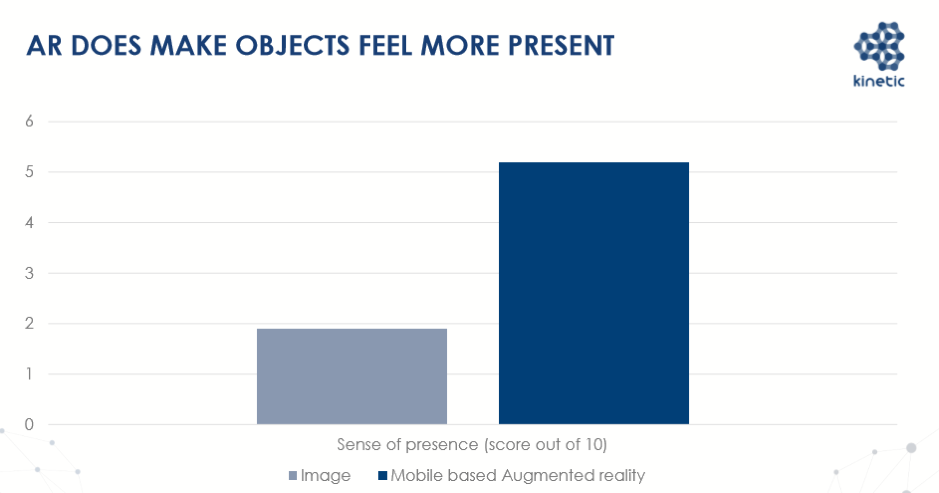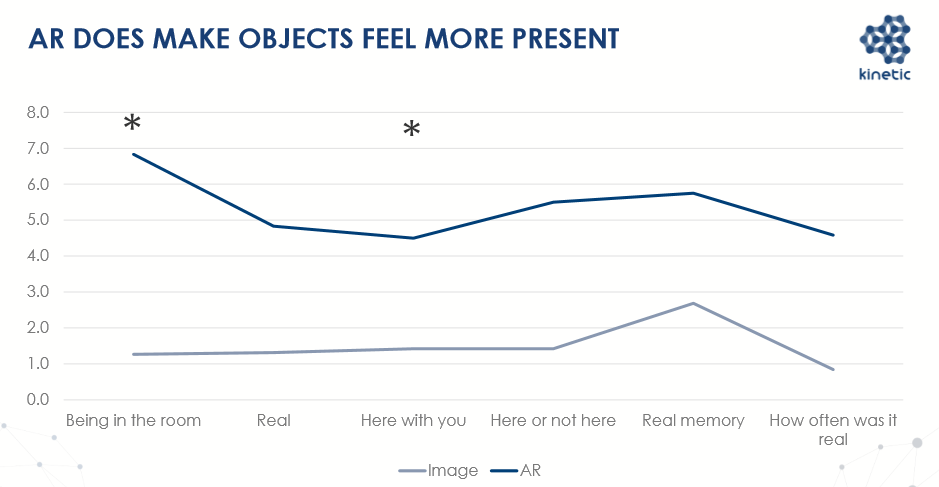Our WARC exclusive unveils new research into the psychology behind augmented reality (AR) and its potential as a new media channel. In partnership with WPP outdoor advertising specialist, Kinetic, our research paper explores the psychological impact AR can bring to out of home advertising (OOH) in order to build emotional connections between brands and consumers.
Published exclusively in WARC, our research discovered:
- How AR connects with people better than other physical media using established psychological principles of virtual reality (VR)
- How this insight can be leveraged to drive awareness and greater use of the OOH medium for marketers and media planners
Key takeaways
- Why AR should be considered as a new media channel revealing the technological innovations that are disrupting the media landscape and how brands should use them to build into their media plans.
- The impact of 5G upon the OOH media landscape and how it can be leveraged to improve the ways brands connect to consumers.
- Methodology of the investigation adapting the Slater-Usoh-Steed (SUS) questionnaire in association with Ipsos, to indicate how the sense of presence created using VR is also created by AR experiences.
- The findings reveal the responses to AR technology, that can be adapted and developed for the OOH medium, which is increasingly important in today’s technologically charged society.
In brief
Against a backdrop of constantly changing technological innovation brought about by the new possibilities from 5G, Kinetic looks at what the impact of Augmented Reality will have on the OOH media landscape. We wanted to understand how the psychology of AR works, and how it can be applied to OOH now that digital is fast taking hold of the medium.
With 5G changing AR, making it faster and more programmable, there is scope for brands to leverage this technology more readily to both enrich the advertising experience and build emotional connections; enabling the consumer to be closer to the brand, boosting the bottom line and growing the business in the long-term.
What are Virtual Reality and Augmented Reality?
As technology has evolved, our media channels have also changed. From the first keyboard in the 1970s, to the launch of social media platforms in the 2000s, the way in which we interact with media has evolved beyond recognition thanks to advancements in tech. Visual technologies such as VR and AR is the result of this journey, and is set to define our relationship with media for future decades even further; we’re already seeing multiple applications of AR via mobile and are starting to see interactive AR wearables – such as Magic Leap, Microsoft Hololens and strong rumours of Apple glasses – that are able to augment our realities. We’re now seeing this technology become integrated across multiple touchpoints.
Why 5G is going to change AR (and VR)
Augmented reality will be made far more accessible with 5G. Indeed, 5G opens-up the possibilities of accessing things more easily when out and about. It is cheap and quick to do, and enables users to do things in real time, without the delays which we often experience right now.
Drilling down into the technical details, AR is built on models, which can be quite large. 5G, with increased download speeds, means complex AR models can be downloaded quickly. AR is also processor-heavy, which means you need software to ‘onboard’ devices such as AR Kit and AR Core. With 5G, this ‘onboarding’ will be done in the cloud, resulting in more accessible experiences. Along with this, OOH can work with AR by deepening the overall experience to expand the impact of the broadcast reach, bringing about detailed insights into reaching audiences at the right time, and at the right place, to achieve a targeted activation.
There’s no doubt that AR is a new media channel that can enable brands to connect to people in better ways. However, the focus of research attention to date has been on virtual reality. Therefore, to better understand the implications of AR – particularly as it starts to gain traction – we need to think about its psychological impact.
To explain how AR will improve the ways brands connect to consumers, we need to consider the psychological impact of VR.
Understanding the idea of ‘presence’
Because humans are naturally visually dominated, immersing in VR means our minds are overwhelmed, creating what is called a ‘sense of presence’. Presence is the sense that you feel you are somewhere when you are not and this is the psychology behind AR. This is important as it prompts our automatic reactions. People then react to a virtual environment as if it is real.
So how does VR create presence?
It is created through four separate illusions.
- Place
An old video game is no longer effective when it is less believable. With technology making virtual environments seem more realistic, it is easier for the user to lose themselves in that separate world.
- Plausibility
Within this virtual environment, do things and/or objects react in a realistic way? For example, if you pick something up and let it go, does it drop or fall in the same way as it would in a normal setting?
- Body ownership
An avatar that matches your own body tricks your mind into feeling what that avatar feels. If it touches the avatar you actually feel it.
- Interoception
The mind is constantly monitoring the body’s physiological and emotional state; you feel ‘present’ when your ‘real’ emotions match your expectations of what your emotions should be in a certain situation. For example, if you’re in a VR experience of standing on a plank high in the air, you feel much more ‘present’ if you are standing on a wobbly plank in the real world. This is because both your body state (feeling unsafe on a wobbly plank), and your visual system (feeling unsafe high up) are aligned. Hence you feel far more present in the VR experience resulting in, sweating, increased heart-rate – even though you’re actually completely safe.
It’s tempting to think of this new media channel as something very new. But if you think about it from a psychological perspective, it isn’t. Think of virtual and augmented reality as ‘dual reality’, as ‘dual realities’ are something we experience every day.
Take the dual reality created in the cinema for example. This environment creates two separate realities – one of being sat in the theatre, as well one of being immersed in the film which can cause physiological changes like our heart rate increasing
AR also creates a sense of presence
VR has the ability to transport the user to a place where you are not, but only via a headset. In contrast, AR adds an object to the place you are in via mobile devices. Because of this, AR can be accessed by a large number of people – nearly everyone with a smartphone anywhere. Therefore, understanding AR’s impact is more important than VR.
The methodology
To gain a better understanding of the sense of presence created by AR, we adapted the Slater-Usoh-Steed (SUS) questionnaire; a standard test created to indicate how effective VR experiences are at inducing a sense of presence.
Respondents were asked to compare the sense of presence from seeing a product via AR on a mobile device – where it is possible to see a product in their environment (a tin of beans), compared to an isolated digital image.


The research revealed that AR does make objects feel more present across all measures compared to the digital image. Of note as part of the adaptation of the SUS questionnaire, where the graph shows two peaks, AR revealed significantly greater increases in presence. These were when participants were asked to rate their sense of the object being in the room with them, and whether there were times during the experience when the object was most real. These were both taken as strong indications as to how AR can create presence for objects, by integrating them into the environment that the respondent is currently in.
With 5G set to transform our tech landscape, consumers will be able to use AR experiences to try products out anywhere to have a better experience of what they are like. The technology already exists to trigger a product experience from OOH, making that product feel more present to people, as well as deliver an AR product to an individual, and direct them to where the product can be bought. In effect Out-Of-Home is the new in home.
In summary – the implications for brands and the OOH media landscape
So, what can AR bring to the OOH space? Mainly, that it can deepen the brand experience and provide direction by building stronger emotional connections.
Moreover, the study showed that AR does increase the sense of presence for objects compared to the equivalent of a digital image.
Great advertising is built on branding – so building positive feelings and associations with a brand and activating that. AR has an untapped potential in OOH. Due to OOH’s broad reach, AR experiences can be used as a brand mechanism. Brands that are first to market in this space will also have the benefit of driving distinctive marketing assets. However, 5G means that AR experiences can be activated more easily whilst out of the home. Therefore, if marketers blend OOH and mobile this also gives the opportunity for targeted activation. What underpins this is an understanding of how AR can build emotional connections. And unlike VR, this is a realm where more exploration is needed; both in academia and marketing. We would advocate utilising new technologies successfully by understanding the psychology behind why this can drive emotional connections.
Authors
Jennie Roper, Head of Insight, Kinetic UK.
Dr. Alastair Goode, Cognitive Scientist, Gorilla in the room.


Recent Comments